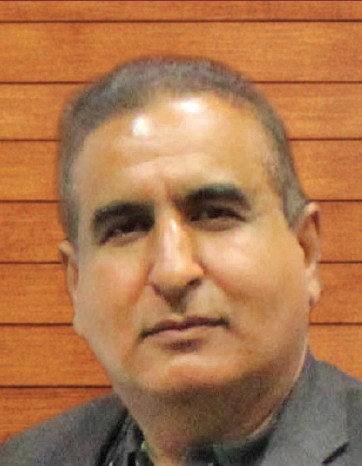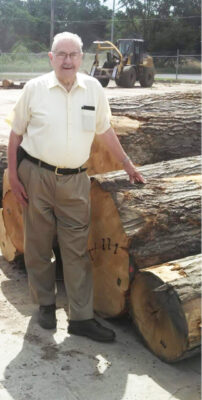
Ray White
Harole White Lumber Inc.
Morehead, KY
As an exporter and domestic producer, I would have to say that 2020 was not a good year. We were able to keep our loyal export customers’ business moving, but at far less pricing.
I believe that the on-going COVID virus will continue to be a problem until a vaccine is available. With the recent tentative Presidential election results, I would expect less pressure with China and USA relationships. The suspension of the tariffs were helpful, but more importantly the shortages of lumber is improving our industry daily. I fully expect that the first two quarters of 2021 to be stellar with little to no slowdowns anticipated. The amount of attrition over the last 10 years has reduced our ability as an industry to adequately supply worldwide and domestic markets. We are 1/3rd of what we were in 2009, sadly. Thus, a period of prosperity should greet us in the coming New Year. Probably the largest problem in our industry is the lack of a qualified labor force. This has been our main problem overall. Again, labor shortages will plague us far into the future. Another area of concern for us will be the ability to keep production at 100 percent and adequately supplying our customer base. Already we are woefully short on air dried and kiln-dried lumber.
Our customers range from end users, distributors, wholesalers, domestic and of course export markets. Our strongest sellers this year have been White Oak in all grades, Poplar in all grades, uppers on Red Oak and specialized Hard Maple cuttings.
We expanded our industrial markets this past year, producing more ties, timbers, fencing, crane mats and specialized cant material. We also increased our Poplar production to supply our secondary finger jointing and moulding operations.
We recently added another finger jointer in our secondary operations to improve our overall production in this market. We continue to focus on efficiency, streamlining our dry line and quality control making sure our customers always receive the highest product exceeding their expectations.
The main problem we have been encountering is the lack of available containers. The global virus disruptions created interruptions with container inventories worldwide. And with continued economy improvements worldwide, container disruptions will continue.

Wendell Cramer
WM Cramer Lumber Company
Connelly Springs, North Carolina
2020 has been a really difficult year due to the starting and stopping of customers’ usage because of COVID-19. Recently, the last couple of months, it has picked up somewhat, and hopefully the rest of 2020 and 2021 will be better for all hardwoods.
The biggest market we sell to is the furniture and cabinet people. That’s what we expect to be a lot better for the rest of 2020 and 2021.
We did not add new services. We didn’t know what was going to happen because the market was so up and down. There was nothing steady about it. Recently, it’s been better. We didn’t install any new equipment; we kept on going with what we had. Fortunately, we survived fairly well due to the fact of how many furniture people were out of work.
In transportation, everything seemed to work really well. You got freight at a reasonable price, and service was good. It was fairly easy to get shipping, so there was no problem there.
The export department started picking up just recently; it’s better, we think, until the end of the year. We’re hoping for a decent rest of the year in our export department.
There are tariffs, but we’re hoping some of the tariffs will be reduced. As most businesses go, there probably will be some tariffs in 2021.

Greg Devine
Abenaki Timber Corp.
Kingston, New Hampshire
2020 was successful. Challenges we see for 2021 are as follows:
•For our industry to retain and develop a sustainable market for low grade timber so that proper forestry can be practiced
•To recruit and retain our labor force
Our customers are importers, distribution yards, cabinet companies, flooring companies and furniture companies. Our strongest sellers this year were Hard and Soft Maple, White Oak, Basswood, Beech and Yellow Birch.
New products we keep confidential. We installed no new equipment this year. We have invested heavily in our people.
Transportation has been pretty smooth this year. We are concerned about China reestablishing the tariff on hardwood lumber in the first quarter of 2021.

Guillaume Genest
Primewood Lumber Inc.
Drummondville, Quebec
Surprisingly, 2020 was not bad, but it was not great either. The Spring of 2020 was a tough period, but the rest of the year was better.
Our top sellers were FAS/F1F White Oak and high-end Walnut.
My feeling regarding the rest of the year about our industry is that I have the feeling we will face serious shortages in many items. This will likely drive the prices up.

Ryan Peterson
Northern Hardwoods
Atlantic Mine, Michigan
In general, with the exception of two months during the shutdown, business has operated at a high level. Northern Hardwoods prides itself on keeping all of its labor pool employed and safe during the COVID-19 pandemic. There are still gains to be made on customers returning to normal levels of business, but trends are in the right direction. Raw material availability in the Lake States Region in general will be an issue in 2021 as sawmill capacity – as well as logging capacity – has decreased in the region in 2020.
We sell primarily into the cabinet, RV, distribution and flooring industries. Hard and Soft Maple and Red Oak continue to be our driving species, and all have been strong this year, all things being considered.
Northern Hardwoods continues to explore more value-added services for our customers as well as proprietary sorts for our customers to bring added value to them. Northern Hardwoods has installed two new Vision Tally systems this year, one at each of their facilities. We’ll continue to invest capital into more customer facing equipment such as value-added capabilities. At the same time, we will continue to invest in upgrades at our facilities to keep our employees safe and our process efficient.
Transportation, domestically, has begun to tighten up with more product moving around the country. Containers domestically, and for export, have been in good supply.
End of the year 2020 brings uncertainty with regards to potential tariffs being placed on our product. Northern Hardwoods has minimal exposure to the Chinese market, but the ripple effects of less product being sold into China from the Appalachian and Southern producers causes over-supply issues domestically. China is a necessary market for certain hardwood lumber items; without them, our industry would see even more capacity decreases and closures.

Joe Gori
Lawrence Lumber Company
Maiden, North Carolina
2020 has been definitely a very chaotic year. COVID has created many challenges and changed many ways of life in the whole world. We are seeing shortages of lumber, due to closings of many mills, and there will be even less availability in the coming months with the cold weather upon us, so we are buying all we can right now.
In 2021, we all hope that will turn around, but at the beginning this chaos will definitely follow into the new year, so no changes in my opinion unfortunately. But at the end of the day, lumber is moving well and customers are buying. The factor of low green availability is going to raise the request, so by having lumber, we are not having challenges in moving it.
We are seeing, on our end, lots of requests in White Oak. This has been a very strong specie, and the shortage of it has driven the price up. Every load we put out gets sold instantly. Also, Hickory has been a strong specie for the European market.
We have installed a new ripping and surfacing line which has been giving us the opportunity to diversify and produce new products into the domestic and export markets. These lines are operational and have been since early this year, so we are very happy with the outcome of this investment – despite the way this year has turned out. I believe investing in new machinery is very important, and that is what we will keep doing here at Lawrence. Our new machinery will be very beneficial to offer a new more semi-finished product to diversify our inventory and give customers a value added service.
As of now, we have seen rates at an all-time low according to our freight forwarders, but now it’s starting to go back up again. Equipment is available and we have not had any challenges, thankfully.
We will see what other tariffs will be in place if any, but it’s definitely not beneficial for anyone. It should be an all-fair-trade for everyone. And since the world has become small over the past 50 years, we all need each other’s products. So, we will see what happens.

Bo Hammond
Collins
Portland, Oregon
It goes without saying that success is relative, but 2020 made this quote on success from Winston Churchill equally relevant: “Success is walking from failure to failure with no loss of enthusiasm.” Between trade wars that carried over into early 2020, but then reached favorable resolution, to diminishing markets, to then getting hit by pandemic issues, to now experiencing a serious supply shortage, 2020’s success has truly been defined by perseverance. Collins’ hardwood business, like many others, took some hits in 2020. As part of realigning our business to shrinking hardwood demand worldwide, Collins closed the Richwood, WV sawmill and kilns. But, with a continued enthusiasm for the hardwood business’ survivability, Collins expanded production and increased kiln efficiency at the Kane, PA facility. This created additional capacity that supports buying supplemental green and KD lumber into our Kane facility, and Collins is custom drying lumber opportunistically to keep our developed customer base supplied.
This year cemented some unfortunate realities for the hardwood business. Flooring and cabinetry, the two primary housing related segments that drive demand levels for hardwood lumber, have both seen decreased usage of solid hardwoods in their products. Substitutes and fashion trends that diminish the importance of solid hardwood usage in cabinets and floors, have seized market share that used to be dominated by hardwood lumber. The largest export market for hardwoods finally hit the peak of its growth and, through difficult trade negotiations, replaced some of the volume of hardwood imported from the US. These trends were not spontaneous; they have been building, and their culmination this year, along with uncontrollable factors faced worldwide, will result in a further contraction of the hardwood manufacturing industry as it realigns supply with available ongoing demand.
Recognizing these changes in markets and demand, Collins made a decision to improve efficiencies, remove cost from its manufacturing process where possible, enhance the quality of our products, and take control of our own narrative with our reach into the hardwood market space. We installed a combination bin sorter/stacker to Kane’s sawmill to combine two machine centers into one, improve the efficiency of changeovers, reduce our dependence on manual labor and add sorting capabilities to our green chain. We instituted a strict QC program for wane allowance, manufactured defects and package presentation. We regained the ability to straight line and gang rip lumber as a value-added offering for our customer base to better service their downstream customers. And, we continually promote and communicate our corporate philosophy about sustainability as a driving force in managing our FSC certified company lands, but also as a tool to drive sales to a new customer base that is searching for a reason to choose hardwoods. Being the cheapest choice is not a long-term strategy by itself. Consumers have to appreciate the value in hardwoods beyond price; and we, as a forest products company, and part of the hardwood industry, have to create that appreciation where it doesn’t currently exist.
Looking ahead into 2021, the pieces are in place for a strong start. Supply shortages that have plagued other forest products segments, are starting to impact hardwoods, and some of the curtailed supply will not come back short-term. Timber availability is going to be as real a threat as logger availability has been in past market swings. Housing construction and starts have strengthened through the pandemic, and pent up demand for single family housing seems like it will persist into 2021, boding well for cabinetry, millwork, furniture, and even flooring to show gains in 2021. Manufacturing in the U.S. is continuing to restart and gear up from pandemic-induced closures, and supply chains have yet to be completely rebuilt. Plus, Pine has become outpriced to pallet manufacturers, so gains will continue into early 2021 for industrial products. Railroads have slowed their maintenance plans, but the need for track replacement and maintenance is only on hold. The key for the second half of 2021 and beyond is how our industry reacts to the recovery of demand and the impact of supply shortage on price increases. The hardwood industry is known to be able to out-produce any market, because we gravitate to more volume as a solution for more profit. However, in hardwoods, profit margin doesn’t come from volume alone. Controlling costs, creating value added markets, building a reputation as a quality manufacturer with consistency, and servicing customers impeccably are where margin is created. Threats to the hardwood industry exist; consumers not viewing wood as a serious choice, is a threat. Eradicating the marginal relationship between timber prices and lumber prices by overpaying for logs or overproducing markets is a threat. These threats are not original. The hardwood industry has faced all of these to varying degrees before. Approaching these threats as challenges and opportunities to succeed is the key for companies surviving in the hardwood industry. Best of Luck in 2021!

David Whitten
Bingaman & Son Lumber Inc.
Kreamer, Pennsylvania
These comments come from an export perspective.
Was 2020 a successful year? Well, if your definition is accomplishing the goals we set in the end of 2019, no. If your definition asks: did we get up every time after getting knocked down, and try again? Then yes, we were very successful.
While we are still in the throes of COVID-19 at the time of this writing, our biggest challenge currently and in the near future is to navigate the greatly diminished demand for hardwoods in China, amidst still too much production. Bingaman and Son Lumber as well as our industry have depended in general upon globalization for the last 10-plus years; cheap and easy ocean shipping, and a growing middle class in China who prized real hardwood products. This drove demand and prices for Ash, Cherry and Red Oak.
Several things out of our control in recent years and YTD 2020 have erased that premise: COVID-19 of course, but also ongoing trade tensions amidst China’s middle class stagnation, has driven demand for hardwoods down in China. Over-production against waning demand is our key challenge.
I like to sail and have spent my share of time in a dead wind, a little time in a fog, and a couple times in a strong current. But I’ve never been in a fog with a dead wind, without a current, like it feels now in the hardwood business. If you’ve seen the Redford movie, “All is Lost,” you know what I mean (summed up in the one word spoken in the film).
Practically all of the landmarks we used to navigate by are gone. It seems our generation of growth by globalization has run its course. China will probably still be the No. 1 destination for hardwoods overseas, albeit with greatly diminished volumes. The EU is reasonably healthy, and there are emerging markets in Southeast Asia, India, South America and Africa. But all those overseas markets combined won’t replace what China was in 2012-2018. The U.S. consumer may warm up to genuine hardwoods, especially if we can unify behind a well-funded marketing program. But, who knows when that may happen. Or, perhaps a cap and trade “green biofuel” policy will add value to our forests and products…some are already investing accordingly.
Our companies’ broad range of products to a broad range of customers, kept us afloat. Bingaman markets logs, KD lumber, ripped strips, face glued blocks, and Thermal modified decking. We didn’t add any new products or new equipment in 2020, other than some maintenance upgrades here and there.
Regarding transportation, U.S. trucking has been tough/high priced/hard to find while overseas shipping rates are low, and space reasonably available. We don’t expect a return to hardwood tariffs with China or others, because we think commodity values are already so low there’s not enough money involved…but who knows?
While this is a business article, the truth is that whatever success we’ve had, is rooted in grace. Grace that gives strength to get up after the countless times of falling down, grace to do the right things right, grace under fire. It’s grace that comes from outside us, from God, that is our guiding light. So, it’s by His grace that we are hopeful for a good 2021 and beyond.

Kamal Sanghera
San Group of Companies
Langley, BC
Overall there have been lots of challenges this year, but we’ve successfully met them all. We are on course with our projections growth-wise. How we move forward depends upon COVID but so far production is up and looking good for 2021. Government policy changes have been positive for us. Tariffs could cause problems but that’s the cost of doing business.
Our customers are a balance between domestic and export. The domestic market is growing and currently approximately 8 to 10 percent of our sales. Everything is experiencing strong demand because Cedar is highly sought-after.
We are expanding our domestic market and supporting our vision of “Harvest to home.”
We are undertaking a huge investment in new, integrated advanced wood manufacturing capacity. Our new facilities, at this point highly focused on three sites in the Alberni Valley, are dramatically increasing our production and products.








